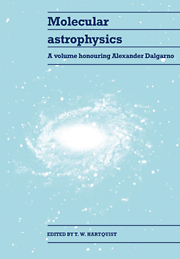Book contents
- Frontmatter
- Contents
- Dedication
- Preface
- Part I Molecular clouds and the distribution of molecules in the Milky Way and other galaxies
- Part II Diffuse molecular clouds
- Part III Quiescent dense clouds
- Part IV Studies of molecular processes
- Part V Atomic species in dense clouds
- Part VI H2 in regions of massive star formation
- Part VII Molecules near stars and in stellar ejecta
- 23 Masers in the envelopes of young and old stars
- 24 Chemistry in the circumstellar envelopes around mass-losing red giants
- 25 Atoms and molecules in Supernova 1987A
- Part VIII Moderately ionized gas and chemistry at large redshifts
- Index
24 - Chemistry in the circumstellar envelopes around mass-losing red giants
Published online by Cambridge University Press: 10 December 2009
- Frontmatter
- Contents
- Dedication
- Preface
- Part I Molecular clouds and the distribution of molecules in the Milky Way and other galaxies
- Part II Diffuse molecular clouds
- Part III Quiescent dense clouds
- Part IV Studies of molecular processes
- Part V Atomic species in dense clouds
- Part VI H2 in regions of massive star formation
- Part VII Molecules near stars and in stellar ejecta
- 23 Masers in the envelopes of young and old stars
- 24 Chemistry in the circumstellar envelopes around mass-losing red giants
- 25 Atoms and molecules in Supernova 1987A
- Part VIII Moderately ionized gas and chemistry at large redshifts
- Index
Summary
Introduction
When low and intermediate mass stars evolve off the main sequence, they become red giants. During the first ascent up the red giant branch, the stars lose mass at a relatively modest rate (∼10−9 M⊙ yr−1. Dupree (1986)). However, during the second ascent up the red giant branch, the asymptotic giant branch (AGB), stars lose mass at a much greater rate; up to 10−4 M⊙ yr−1 (Zuckerman 1980, Jura 1986a, Olofsson 1985). These outflows from AGB stars are very cold (T < 1000 K), and they contain large amounts of dust and molecules. The chemistry in these outflows is the topic of this chapter (see also Olofsson (1987), Omont (1987), Millar (1988)).
Stars derive most of their luminosity from nuclear reactions that occur in their interiors. In the red giant phase, material from the interior is mixed with that at the surface and the composition of the photosphere of a red giant can be very different from the star's initial composition. In most cases, it appears that in the atmospheres of the red giants, the major elements are still hydrogen and helium, even though material is mixed from the interiors to the surface. However, the next most common elements, carbon, nitrogen and oxygen, may have very nonstandard compositions, and this can greatly affect the chemistry. In particular, the ratio [C]/[O] is critical. In the usual thermodynamic description for material in cool stellar atmospheres, we expect CO, because of its very high binding energy, to contain as much carbon and oxygen as possible.
- Type
- Chapter
- Information
- Molecular AstrophysicsA Volume Honouring Alexander Dalgarno, pp. 424 - 438Publisher: Cambridge University PressPrint publication year: 1990
- 3
- Cited by

